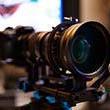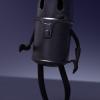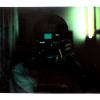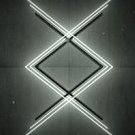-
Posts
79 -
Joined
-
Last visited
Reputation Activity
-
 powderbanks got a reaction from NikolaOvcharski in Confused about Frame Rate rules versus Light rules
powderbanks got a reaction from NikolaOvcharski in Confused about Frame Rate rules versus Light rules
Frame rate has no relation to exposure or light. Frame rate is how many individual pictures are being exposed/projected per second. Shutter speed is how long the shutter stays open, in seconds. The only thing you need to know about shutter angle is that it effects motion blur between frames.
B: The light 'trio' of aperture, shutter speed and ISO is really for digital stills. For video, only consider ISO and aperture for controlling your exposure. Since DSLR's don't have a global shutter and you can't control the shutter angle, the only way you can control that is by your shutter speed (hence the 'inverse of twice the frame rate'). White balance really doesn't have anything to do with exposure. To a degree it does, but it is the temperature of the color white. Higher numbers give you a warmer (yellow/orange) white, lower numbers cooler (blue) white.
2. It depends on the situation, but I usually set the aperture first then use the lowest ISO I can and still retain proper exposure. I shoot at 1/40 shutter speed, you get a little bit more motion blur, but it's barely noticeable compared to 1/50 (for 24fps. I shoot 1/125 for 60fps). Don't even think of shutter speed in terms of a way to adjust your exposure. Leave it at whatever it is for the given frame rate (1/40 or 1/50 for 24/25fps or 1/100 or 1/125 for 50/60fps) and don't change it; unless you intentionally want to manipulate the motion blur. See below.
3. If you make your shutter speed faster, you'll lose more motion blur between frames, and motion starts to look artificial/strange. But if that's what you're going for, do it. If you slow it down (the GH2 can only go down to 1/30, I think, in 24fps) then you'll have the opposite. You can get down to 1/2 second shutter speed in Manual Movie Mode with the GH2, but IMO, it's only good for time lapse stuff.
So really, there is no rule of thumb, aside from the 180 degree shutter concept for 'natural' motion blur. The challenge of shooting 1/40 or 1/50 shutter speed is that it is a rather slow shutter speed. In bright, outdoor situations, to retain shallow depth of field, you'll need to use an ND filter. You can get sets or a variable one.
-
 powderbanks got a reaction from Wit in Confused about Frame Rate rules versus Light rules
powderbanks got a reaction from Wit in Confused about Frame Rate rules versus Light rules
Frame rate has no relation to exposure or light. Frame rate is how many individual pictures are being exposed/projected per second. Shutter speed is how long the shutter stays open, in seconds. The only thing you need to know about shutter angle is that it effects motion blur between frames.
B: The light 'trio' of aperture, shutter speed and ISO is really for digital stills. For video, only consider ISO and aperture for controlling your exposure. Since DSLR's don't have a global shutter and you can't control the shutter angle, the only way you can control that is by your shutter speed (hence the 'inverse of twice the frame rate'). White balance really doesn't have anything to do with exposure. To a degree it does, but it is the temperature of the color white. Higher numbers give you a warmer (yellow/orange) white, lower numbers cooler (blue) white.
2. It depends on the situation, but I usually set the aperture first then use the lowest ISO I can and still retain proper exposure. I shoot at 1/40 shutter speed, you get a little bit more motion blur, but it's barely noticeable compared to 1/50 (for 24fps. I shoot 1/125 for 60fps). Don't even think of shutter speed in terms of a way to adjust your exposure. Leave it at whatever it is for the given frame rate (1/40 or 1/50 for 24/25fps or 1/100 or 1/125 for 50/60fps) and don't change it; unless you intentionally want to manipulate the motion blur. See below.
3. If you make your shutter speed faster, you'll lose more motion blur between frames, and motion starts to look artificial/strange. But if that's what you're going for, do it. If you slow it down (the GH2 can only go down to 1/30, I think, in 24fps) then you'll have the opposite. You can get down to 1/2 second shutter speed in Manual Movie Mode with the GH2, but IMO, it's only good for time lapse stuff.
So really, there is no rule of thumb, aside from the 180 degree shutter concept for 'natural' motion blur. The challenge of shooting 1/40 or 1/50 shutter speed is that it is a rather slow shutter speed. In bright, outdoor situations, to retain shallow depth of field, you'll need to use an ND filter. You can get sets or a variable one.
-
 powderbanks reacted to RobertoSF in Will we see a new professional Panasonic GH-series camera at NAB?
powderbanks reacted to RobertoSF in Will we see a new professional Panasonic GH-series camera at NAB?
I would add to the list the ability to switch the sensor to record in the 4:3 aspect ratio. This would make a lot of anamorphic shooters very happy. So would 10bit 422, more DR, and an ND wheel.
Fingers crossed for a Panasonic announcement at NAB
-
 powderbanks got a reaction from nahua in Ideal settings for GH3? (color grading and a first example)
powderbanks got a reaction from nahua in Ideal settings for GH3? (color grading and a first example)
personally, i'm not a big fan of the warp stabilizer. it can end up causing some really weird warping and jelloing (which technically i suppose is working correctly, but i don't like it) in more shots than expected; if i need to do some stabilization i like using the motion tracking in AE. but that's kind of moot since OP is using final cut.
1) it is and it isn't a 'lesser' HD. the difference is in the ipb frames, frame rate and bitrate. the all i hd mode means every frame at 24fps is its own individual 'picture,' whereas other modes there are predicted frames between the keyframes. this allows more compression of the video. for the most part, it's hardly noticeable, especially at 60fps. frame rate, 24fps vs 60fps, pretty obvious. if you take your 60fps footage and conform it to 24fps, you have some really nice ~40% slow motion. and with the lower bitrate as well, as nahua said, it will take up less space on your memory card (helpful for #4).
2) it looked like there was a little bit of banding in the opening fade in from inside the tent. though i think it was only exacerbated by the fade in.
3) i shoot with a gh2, but i have the noise reduction as low as possible, no matter what i'm shooting. if i get into the higher iso's, i just make sure i use a faster lens (or add lights to the scene if i can) to help lessen the amount of noise in the darker areas of the image. and if i go the whole way to 12800, the only way to make it really usable is to shoot it in b&w; and even then, bumping up the NR does very little.
4) the image flatness/color profile should remain near enough the same between the AVCHD and h.264 video
-
 powderbanks got a reaction from galenb in Best camera for 60fps to Slowmo at 720p or 1080p?
powderbanks got a reaction from galenb in Best camera for 60fps to Slowmo at 720p or 1080p?
OP could even get by with a gh1. the hacks for that when i used it were great as well. last i saw the gh2 body was going for $500 on amazon. pair it with a canon fd mount 50mm/1.8 or 1.4 and you should be set. though with the crop factor, 50mm (100mm equiv) could potentially be a little too long, depending on your photobooth setup. if you need autofocus, go with a native lens
-
 powderbanks got a reaction from tomekk in Why I think Canon have forgotten the indie filmmaker
powderbanks got a reaction from tomekk in Why I think Canon have forgotten the indie filmmaker
gh2/3, and really m4/3 in general, was never really intended for the pro photographer. until the gh3, panny never really incorporated 'pro-user' features; or at least advertised them as such. the gh series just happened to have some really good video output, and then only made better by vitaly and others. if you look at how these cameras were/are marketed, the intended segments aren't the pro photographer, let alone filmmaker...the users made them as such.
i don't think it would make sense for canon to make a specific 'gh3 killer,' because if you look at the buyers of these cameras, i'd say the indie filmmaker is actually a fairly small percentage. canon wouldn't make a full frame, top of the line 'pro model' dslr, and then cram it full of top of the line 'pro model' cinema eos stuff as well. people shooting dedicated stills don't need 4:2:2 color, 4k or any of the lauded video features; and people shooting dedicated video may not want the dslr form factor, rolling shutter issues or so on. it reminds me of the 'old' car saying, 'fast, cheap, reliable...pick 2.' there is no such thing as the 'perfect' all-in-one; in cameras or otherwise, because it has to be good at everything, it doesn't excel at anything.
if you already haven't bought into a canon/nikon system, (someone like me) m4/3 is at a more affordable price point for lenses (legacy lenses). there are drawbacks with crop factor, manual focus and so on, but i rarely use autofocus, even for stills, and i really haven't had any issues with the 14mm end of the kit lens not being wide enough. so for me, and i think many others, the benefits of a great video camera, pretty decent stills camera, a bunch of adaptable, fairly affordable, lenses, smaller form factor and other little details (audio levels, histogram, pretty much no moire, etc) and then the pricing of the cameras themselves, brought them to their purchasing decision. i believe canon will remain top of the camera makers, for a while. but these kind of oddball cameras like the gh series are doing enough to cause the big guys pay attention
-
 powderbanks got a reaction from Sean Cunningham in low light anamorphic video
powderbanks got a reaction from Sean Cunningham in low light anamorphic video
i shot this last night. used the smc takumar m42 55mm/1.8 with a sankor compact anamorphic. all shot at pretty high iso's, mostly 12800, but some shots were at lower. there's 2k mjpeg, 1080p/24fps and 720p/60fps (@24 fps) all in there, i used driftwood's sedna b matrix/patch, because i grabbed my bag on the way to the pier; i would've preferred to use the canis majoris night patch and 2fps mjpeg, but oh well. no color correction/grading
https://vimeo.com/57121092
-
 powderbanks got a reaction from brucker in Patch/Hack Question: MJPEG Anamorphic 2x 4:3 at 70Mbit 1920×720/30p
powderbanks got a reaction from brucker in Patch/Hack Question: MJPEG Anamorphic 2x 4:3 at 70Mbit 1920×720/30p
the noise is due to the way the different codecs work; and probably also the way the camera is putting the image it into the 1920x720 frame..something like with what happens in extele mode. mjpeg is also only in 30fps. i have a 2x anamorphic and i rarely use the mjpeg modes. though i did find a patch that takes the hd mjpeg mode into 2k...so i need to test that out. the footage is still plenty usable. i shot this video with a 2x anamorphic and the canon fd 50mm/1.8. i was curious to see how the anamorphic fared handheld..(i'm still getting used to the dual focusing, there's some spots, most notably in the interview bits, where i was off..)
https://vimeo.com/53870989
the only reason i'd use mjpeg is for the instant aspect ratio correction. and i can get ~2hrs of footage on my 64 gb card in mjpeg as opposed to just under 1hr in avchd/24p cinema mode (driftwood's canis majoris night or sedna patches). if you use the mjpeg mode, you don't need to do anything to the aspect ratio; it's correct and properly de-squeezed to use right off the card. for avchd footage that i shoot anamorphic, i interpret the footage and force the pixel size to anamorphic 2x.
and the only reason why it is in mjpeg mode is because you can't adjust the avchd dimensions like mjpeg. i'm guessing it has to do with the avchd codec being designed for hd formats, so it only works with the standard 1080/720 dimensions..but that's a complete guess. another advantage of mjpeg is that you can drop the frame rate down to 2fps for timelapse. i'm not sure if it would work to change the framerate to 24fps, without having issues. i haven't seen a patch with that, so i would assume it crashes.
-
 powderbanks got a reaction from brucker in gh2 c-mount lenses and anamorphic test
powderbanks got a reaction from brucker in gh2 c-mount lenses and anamorphic test
i made this video a few months back after picking up some cheap c-mount lenses and an anamorphic lens off of ebay. it was really more for me to see how i could use some of the lenses and image quality from the cheapo c-mounts. this was the first time i had shot with an anamorphic, so there are a couple shots where the focus and/or alignment is off. i think i'm going to redo the test at night to get an idea of how they do in low light.
thoughts, comments, critiques are welcome
[url="http://vimeo.com/49446155"]http://vimeo.com/49446155[/url]
info from the vimeo page if you don't feel like making the jump:
24H Cinema = 1080p/24fps
SH = 720p/60fps
VGA MJPEG = 1920x720 MJPEG @ 30fps
ISO400
shutter speed: 1/50 (for 24fps), 1/60 (for 30fps), 1/125 (for 60fps), 1/2 for last two brief time lapses
white balance: 9000K, -2 m
film mode: smooth, -2 on all
OIS: off (with kit lens)
iDynamic: off
iResolution: off
patches: Driftwood GOPSTOPPA (for avchd) and EOSHD MJPEG anamorphic (for MJPEG)
lenses: panasonic 14-42mm/f3.5-5.6
unknown brand c-mount 25mm/f1.2
fujinon c-mount 2.8mm/f2.2
zenitar m42 mount 16mm/2.8
canon fd mount 50mm/f1.8
toyo fd mount 28mm/f2.8
sankor compact cinemascope anamorphic with VAMP clamp
music: dj concept - 'the mask is slipping'
no color correction/grading
-
 powderbanks got a reaction from jgharding in How to imitate the physicality of film?
powderbanks got a reaction from jgharding in How to imitate the physicality of film?
check out the 'wiggle' expression in after effects..sounds like it'll accomplish what you're looking for
[url="http://www.videocopilot.net/basic/tutorials/09.Expressions/"]http://www.videocopilot.net/basic/tutorials/09.Expressions/[/url]
edit: posted too slow..but that'll give you a tutorial of how to make it work







